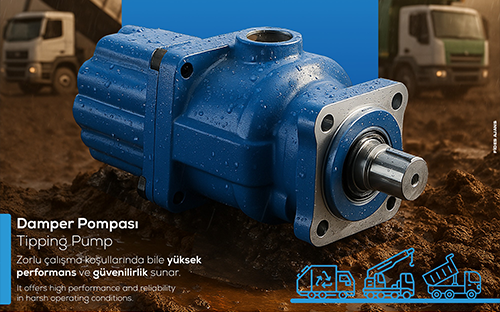
One of the most critical hydraulic components in heavy-duty vehicles is the tipping pump. This pump plays a vital role in lifting and unloading operations, especially in tipper trucks, trailers, construction machines, and agricultural vehicles. Thanks to its high-pressure capacity, durability, and efficiency, the tipping pump ensures reliable and safe performance in demanding applications.
In this article, we will explain what a tipping pump is, how it works, where it is used, and what determines tipping pump prices.
A tipping pump is the central unit of the hydraulic tipping system. It converts mechanical energy (received from the vehicle’s engine or PTO – Power Take-Off) into hydraulic energy, generating fluid pressure. This pressurized hydraulic oil is transferred to tipping cylinders, which lift the truck bed to unload the load.
The performance of the tipping pump directly impacts unloading speed, efficiency, and overall operational safety. For this reason, tipping pumps are designed to handle high pressure and long duty cycles.
The applications of tipping pumps cover a wide range of industries and vehicles:
Tipper trucks and lorries
Trailers and semi-trailers
Construction machinery (excavators, loaders, dumpers, cranes)
Agricultural machinery (tractors, harvesters, and trailers)
Mining and industrial transport vehicles
In short, wherever heavy loads need to be lifted and discharged, a tipping pump is essential.
Depending on the application and system requirements, there are different types of tipping pumps:
Gear-type tipping pumps – robust, cost-effective, and widely used.
Piston-type tipping pumps – designed for high-pressure, heavy-duty applications.
Axial piston tipping pumps – compact, efficient, and suitable for advanced systems.
Each type of tipping pump is engineered to meet specific flow rate and pressure demands.
Tipping pump prices vary based on multiple factors:
Type of pump and capacity (gear, piston, axial piston, etc.)
Flow rate and pressure specifications
Vehicle or system application (light, medium, or heavy duty)
Brand, quality standards, and certifications
Local production or imported equipment
In general, gear-type tipping pumps are more affordable, while piston and axial piston tipping pumps are priced higher due to their superior performance and durability.
When selecting a tipping pump, it is important to consider the following:
The pressure and flow rate required by the system
Durability, warranty, and service life
Availability of spare parts and service support
Energy efficiency and reliability under continuous operation
A well-chosen tipping pump not only improves efficiency but also reduces long-term operating costs and ensures safe load handling.
To summarize, the tipping pump is one of the most important hydraulic components in tipper vehicles and heavy machinery. With its high-pressure capacity and robust design, it provides efficient and safe unloading of heavy loads.
Hydrotime, as a leading manufacturer, offers high-quality tipping pumps designed for various industries, combining durability, efficiency, and international standards.
With the right tipping pump, your vehicles and hydraulic systems can achieve maximum performance, reliability, and a longer service life.